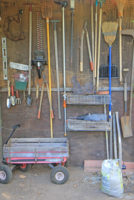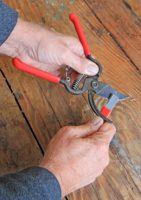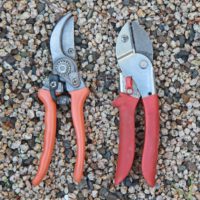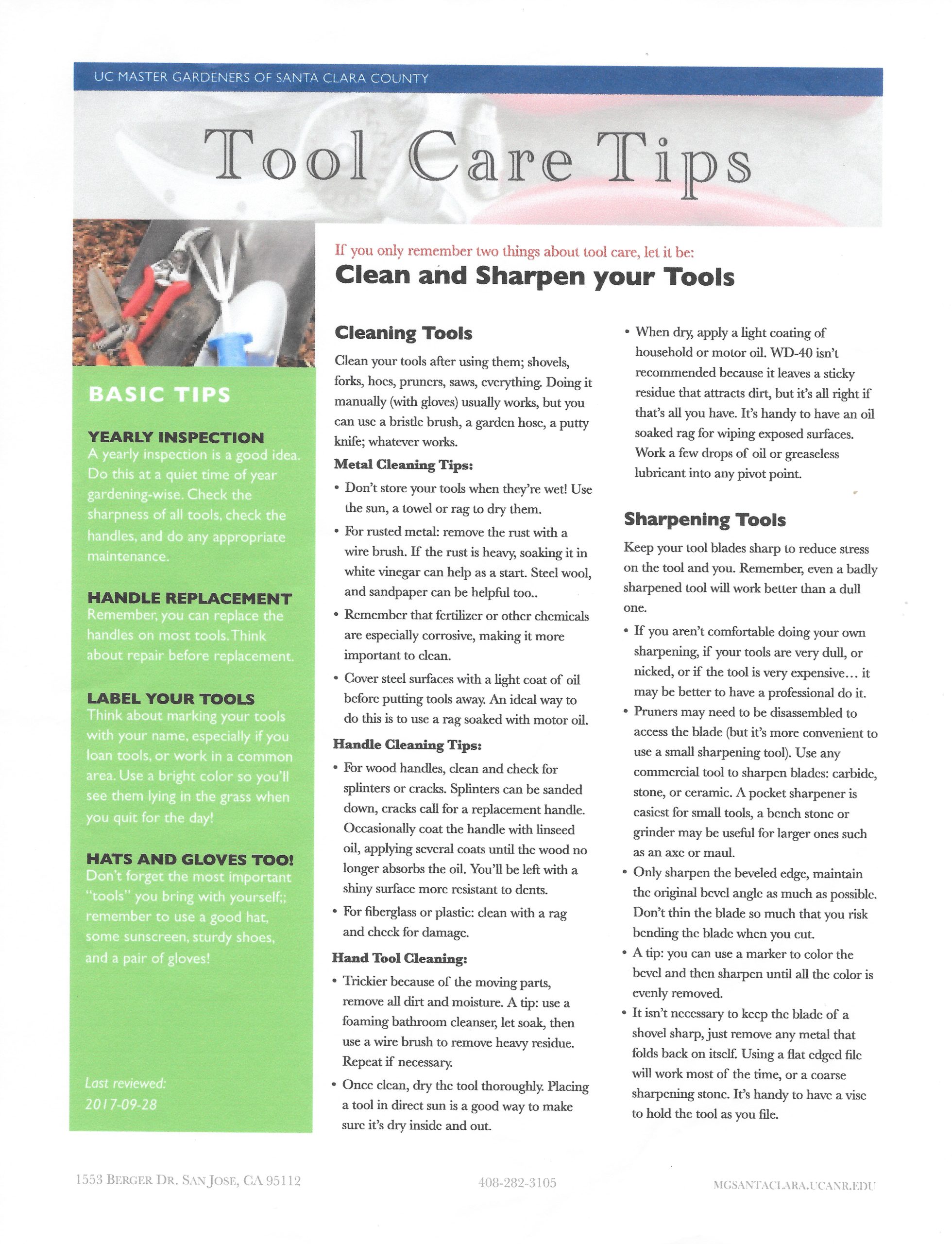Garden Tool Care

Welcome to the Garden Tool Care page of the UCCE Master Gardeners of San Diego County. Tools are important for gardeners. Regular maintenance, such as cleaning, sharpening and sanitizing, plus proper use will keep garden tools functioning and safe for you and the plant. This page provides insight and tips for the home gardener to keep their garden tools in good working condition.
To start, here are good practices to use for keeping your garden tools working well:
- Keep tools clean. Wipe tools with a damp rag after every use. Let them air dry or wipe them dry. Sap, dirt, and wetness can take their toll on garden tools. Never store tools wet as they’ll quickly rust.
- Use the right tool. If you are using excessive force that requires leaning in or using two hands, slow down and go to the next tool up, in relative order: thumb pruner, hand pruners, loppers, hand saw, and power saw. Cut wire with wire cutters. Dig up soil with a trowel. Adjust sprinklers with a screw driver.
- Watch where you lay your tool. Be careful about laying your tool down in the dirt, as grit can quickly dull the workings and blade. For tree or rose pruning, consider putting your tools in a bucket.
- Tighten up. Check if there is wiggle between the blades, and if so, tighten the center nut. Check that blades that are screwed on, are tightened down.
- Label your tools. Mark tools with your name, especially if you garden in a common area or loan out tools. Use a bright color so they will be seen when on the ground. Attach a bright ribbon or piece of cloth for easy detection.
- Protect yourself. Wear a hat and gloves when in the garden. Put on sunscreen and wear sturdy shoes. Be safe and prevent injuries.
Tool Maintenance
Regular inspections, cleaning, sharping, and sanitizing of garden tools will keep them in good shape and improve the health of your garden. An easy way to remember the steps to garden tool care is with the phrase: Scrub * Sharpen * Sanitize. Follow the steps below to keep garden tools in good condition.
Scrub
Scrub the tool to remove debris from the tool with soap, water and a gentle scrubbing pad. A foaming bathroom cleaner is also effective.
Tools accumulate sap when pruning which can 'gum-up' moving parts and leave residue on the cutting blade and anvil. Additionally, fertilizers or other chemicals are corrosive. Regularly cleaning tools ensures improved performance and tool longevity.
Remove any rust with a wire brush. If the rust is significant, soak the tool in pure vinegar for a few hours to overnight, depending on the need. Brush off the remaining rust with a wire brush or steel wool rated 000 or 0000. Repeat if needed.
Sharpen
Sharp tools makes using them easier and safer to use. Cuts will be smoother and there will be less torque on your hands, wrists and arms. Also a cleaner cut is better for the plant and a sharp blade is safer for you should you be cut.
Watch the video below "How to Clean and Sharpen Pruning Tools" for a brief tutorial on tool sharpening.
For shovels, hoes and other non-pruning tools, sharpen if the metal has folded back or feels dull. Use a flat edged file or a coarse sharpening stone. Using a vise to hold the tool is helpful. Take tools with serrated edges, such as a pruning saw, to a professional for sharpening.

Sanitize
Sanitizing garden tools prevents transmission of disease from one plant to another. It should be done prior to pruning and always between pruning plants. Alcohol wipes or a disinfecting spray are effective for sanitizing tools in the field or at the end of the day. Be sure that garden tools are dry before storing. Tools should never be put away wet.
Lastly, oil any joints, blades or metal parts with lubricating oil. This helps to maintain smooth motion for tools with pivots and reduce rust while in storage. Wipe excess oil with a rag and ensure that all the metal surfaces are coated.
Pruning Mechanisms
There are two types of pruning mechanisms: bypass and anvil. A bypass pruner cuts when one blade 'passes by' the other. Anvil pruners cut when the blade presses against a flat lower plate. Bypass pruners are the preferred tool for pruning live plants while anvil pruners work best when cutting dry plant material.
To inspect pruners, look at the blade. If there are divots or nicks, the tool might need to be professionally sharpened. The divots are the result of pruning a tree or shrub that is too big for the tool or cutting something other than a plant. Typically, hand pruners can cut wood with a diameter of ¾ inch while loppers can cut up to 1 ½ inches. For branches larger than 1 ½ inches, use a pruning saw or a rope saw. Check the pivot on the pruning tool for smooth motion and wobbliness. Tighten if needed.

Watch a Video of 'How to Clean and Sharpen Pruning tools' by Allen Buchinski of UCCE Master Gardeners of Santa Clara County
'Tool Care Tips' Information Sheet by Allen Buchinski, UCCE Master Gardener Santa Clara County


